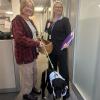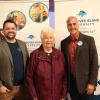February 14, 2007 - 4:00pm
Malaspina University-College and the Malaspina Students’ Union are enjoying the most productive and healthiest institution-union relationship in the province.
Over the past decade the institution and students’ union have been working to improve their relationship so they can better serve students. Now they’ve taken it one step further.
For the past year, students’ union executive director Steve Beasley, and Malaspina Vice-President of Student Services Dr. Patrick Ross, have been working together on a project they call the Collaboration for Student Life Initiative. Their goal is to improve the quality of services and life for Malaspina students by pooling resources and ideas.
“It is a rare combination,” said Ross. “We need to work with the unions to establish a good working relationship. The work we do is about students, not about politics.”
“It’s good for our student body to see there’s motivation to assist them from both ends,” said Beasley. “We want to be an example to the rest of the province that students’ unions don’t have to sacrifice their independence to work with their institution.”
So far, the two have worked on various projects including jointly contributing to funding undergraduate research, eliminating gym fees for students, building the new student residences and co-hosting the annual student orientation events.
One of their biggest projects to date has been establishing a more effective student self-advocacy system. When a student is experiencing conflict, a disagreement or harassment from a professor, instructor, fellow student or administrator, there are systems in place to help them deal with the problem in a positive way. However, up until this year, the system hasn’t worked as well as Beasley and Ross would have liked.
In August 2006, they pooled their resources and appointed Susan Baker as the official student advocate. She works from the students’ union offices at the Nanaimo campus, building 193.
“Susan can provide assistance, advice and support through the process,” said Beasley. “She’s an advocate, not a lawyer or legal representative. As an advocate she helps the person concerned and ensures fairness prevails.
“In the process of dealing with a student advocate, the students are learning how to advocate for themselves – like learning how due process works.”
Now they’ve got the advocacy program going, the two have started discussing a health plan for students, building family residences and discussing student recruitment ideas.
The collaboration isn’t the only way Malaspina students can be involved in the workings of the institution. Student representatives sit on the Board of Governors, are active in the various planning committees, are often invited to the executive meetings, and even help hire new staff.
Tags: In the Community






